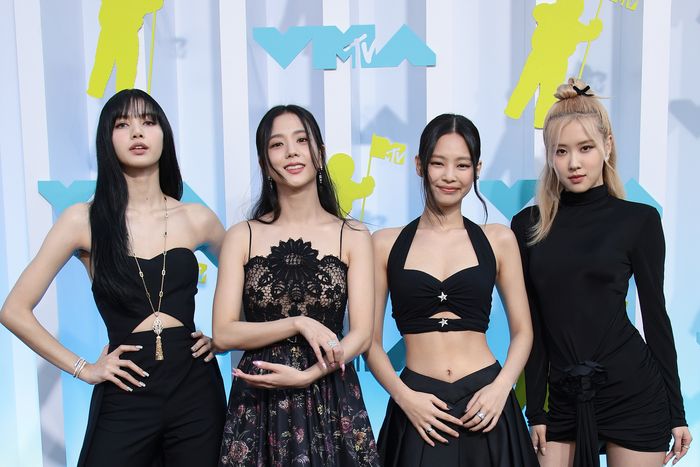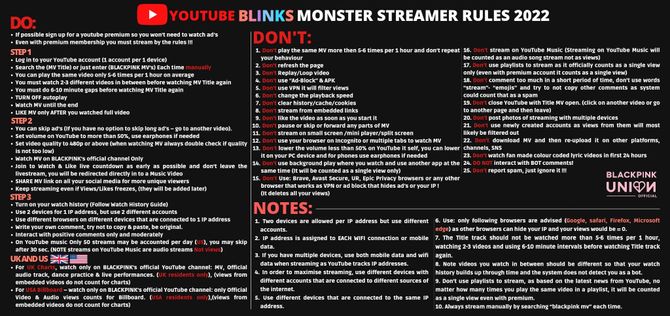
The Blinks hadn’t slept well in weeks. With new music on the horizon, one administrator of the fan account Blackpink Blink Union, who goes only by W, was up all hours planning the campaign for the release of the K-pop stars’ long-awaited second album, Born Pink, which included training new fans on proper streaming techniques, tracking Blackpink’s placement on global charts, and, of course, hitting “Play” on the music video for “Pink Venom” ten times an hour. “That’s what we encourage, so you’re not watching the same video continuously — you’re creating a gap of at least six minutes,” he tells me. “It depends on the leadership of the fandom to stay on top of the streaming rules.” W originally became a Blackpink fan thanks to YouTube’s algorithm (“One day, they were at the top of my recommendation; in a few weeks, I really got involved in it”). Now, as the U.K. leader of what’s described to me as a United Nations of smaller, localized Blackpink fan communities, W is part of a team of Blinks that helps coordinate half a million followers across 60 countries to reverse engineer that algorithm with the goal of keeping Blackpink at the top of YouTube’s charts.
While most K-pop groups release music multiple times a year, Blackpink hadn’t dropped anything since 2020’s The Album prior to “Venom,” which made racking up views for the Born Pink era more important than ever. “There was some speculation leading up to the comeback that Blackpink actually lost fans because of the two-year hiatus,” says Niels Nable, who’s based in the Philippines and tracks goals for the BBU account and r/blackpink sub-Reddit. “So yeah,” he says, Blinks “want to prove that they’re still on top.” The way to do that is by putting up massive streaming numbers to show the size and intensity of the fandom, influence chart placement, break records, and help the band win awards on Korean music shows. “You never hear Blackpink tell us Blinks, ‘We want No. 1 on Spotify or YouTube,’” says Ash, a New York–based admin of the BBU account. (Both Ash and W requested anonymity for this story.) “We are doing it because we want Blackpink to know that we do appreciate the music and that we recognize their hard work.”
While many Blackpink fans have formed their own small-scale online communities, BBU is the largest fan-run Twitter account that actually creates streaming goals and distributes them to its followers. “Views are important,” says W, pointing to “Ready for Love,” a promotional song Blackpink released in July for the video game PUBG Mobile, as a key example. “There was no streaming-platform release,” W says. But “with around 20 million views, we managed to enter the Billboard ‘Global 200’ chart.” When setting goals, they consider things like song length (shorter songs allow for more plays in one day) and past streaming records. They also take into account the streaming “environment,” which could include how much the fandom has grown since the last release, any rumored changes to the YouTube algorithm, and global news events. For “Pink Venom,” BBU hoped to hit 80 million YouTube views in the first 24 hours and push the video to No. 1 on the app’s trending page. (They succeeded at both, achieving more than 90 million views in the song’s first day, putting “Pink Venom” in the top-three highest 24-hour streams in YouTube’s history.) Pulling this off required a massive coordinated effort with fan leaders recruiting, training, and fundraising to help followers buy albums and YouTube Premium memberships. “With regard to tracking views, I usually do it every hour while comparing the real-time numbers with their previous comebacks’ stats,” says Nable. “I play the song while working. I pride myself on being a multitasker.”
BBU began in 2016, before Blackpink had even debuted their first single, and has been guiding Blinks through a rapidly changing streaming landscape ever since, from a 2017 algorithm change that discounted views shorter than 30 seconds to a 2021 change that BBU believes made playlists less effective for increasing views. One of BBU’s main concerns is making sure streaming platforms — YouTube especially — see fans as actual human viewers, not bots. “For ‘Pink Venom,’ we had more work,” says Ash. “More than The Album because we have to give streaming tutorials: how to stream properly, how not to be a robot. You’re not supposed to just replay the video. It doesn’t work like that.” In an effort to discourage stream farming and bot activity, YouTube’s engagement policy forbids “low-quality” streams that appear to be anything other than an authentic individual view. The company uses a number of signals to identify and remove fake views, but these signals aren’t public, so a large part of the fandom’s work is sussing out what counts as a high-quality stream. Blinks gather this information in a number of ways: monitoring the YouTube policy pages for changes; tweeting at @TeamYouTube, YouTube’s technical-support account; hoping one of its staffers will slip them more specifics; and running “algorithm experiments” to see if they can uncover more of YouTube’s unwritten spam signals. Ash tells me they’ll send small groups to watch older music videos — playing three other videos between each stream as opposed to four, viewing the video in a playlist or alone, leaving a comment or not — and track how much the view count increases. “We start analyzing data, like What’s going on? Why are views not moving up? Is it because we’re overdoing it?” They then try to apply new streaming rules to a small group. “If we get 20 streams from this account and only eight views count, maybe create” another account, says Ash.
It’s not exactly scientific, but they’ve figured out what drives views more than many of the platform’s content creators. Eventually, Blinks compiled enough information to distribute streaming rules that are part YouTube policy, part folk knowledge, part fan superstition. W sent me a list of over 60 directives they share with followers. Do: Get a YouTube Premium account to skip ads, type the song name in YouTube’s search bar to encourage higher search placement, and space out streams by watching other videos in between. Don’t: Loop the video, change the playback speed, or comment too frequently. If you can, stream on multiple devices using multiple browsers from multiple IP addresses — all in order to convince YouTube’s spam filters your behavior is totally chill and normal.
But their initial plans for the release of “Pink Venom” didn’t account for YouTube also having something to prove. The single premiered August 19 with an accompanying dance challenge in partnership with YouTube Shorts. “It was a surprise, actually,” Ash tells me of the collaboration. “I just wanted to know how the Shorts affect their trending and how the views grow from it. Because I think if that actually helps Blinks to get attracted to it more, then it would be very nice for everyone to participate.” The decision led BBU to plan their own Shorts challenge for the release of Born Pink in order to test how Shorts can support the fandom’s larger goals. Of course, that’s great news for YouTube — in fact, the rollout plans for many of the app’s products today include K-pop partnerships. The 2021 global launch of the Shorts feature came with a dance challenge to BTS’s “Permission to Dance.” “Blackpink was in the first handful of artists who used the ‘Premiere’ feature on YouTube,” says Vivien Lewit, YouTube Music’s global head of artists. “K-pop artists have a really unique relationship with their fans on YouTube, and for years they have been really the most skilled at tapping into that fan base. They began to produce content in ways that augmented their music and that continued to drive more fandom and more connectivity.”
YouTube and K-pop have been intertwined since Psy’s Gangnam Style became the first video to reach a billion views on the platform in 2012. K-pop is just as much a visual medium as an audio one, and as Ash puts it, “YouTube is the main tool for Blinks, in my opinion, because they love looking at Blackpink.” Once fans start watching, a cottage industry of fan-made meme compilations, dance covers, and reaction videos pops up in the recommendations, serving to deepen and intensify the fan base.
But in recent years, much of the K-pop fandom has shifted to TikTok, where groups now post simplified sections of choreography, performed with members of other groups, as a staple feature of their album rollouts. In 2021, a TikTok trend around Netflix’s Squid Game set to Blackpink member Lisa’s solo track “Money” sent the B-side to No. 90 on the Billboard “Hot 100.” Even though Blackpink has posted their official short-form content exclusively on YouTube, TikTok currently has more than a million videos created with the “Pink Venom” sound compared with YouTube’s 750,000. YouTube is counting on Shorts partnerships with Blackpink and BTS to turn the tide.
BBU leaders are still weighing where TikTok and Shorts fit into their fandom participation, how they can support their streaming goals, and whether they are an authentic extension of their relationship with the band. In the past, Blinks have soundly rejected other plays at their loyalty (like Blackpink-themed NFTs), but they latched on to Blackpink’s role as ambassadors to the U.N. Climate Change Conference in 2021. The fandom started a #ClimateActionInYourArea campaign to plant trees in their local communities as a way to thank the band members for speaking on climate change. Any campaign they take on has to either help them show appreciation for their favorite artists or help the fandom build people power, and they’re determined to keep breaking records whether or not short-form video helps them. While BBU is proud their efforts have propelled “Pink Venom” to global success, they’re nowhere near finished. Early Sunday morning, the BBU Twitter account was suspended (they suspect mass reporting from rival fandoms), but they immediately restarted their streaming campaign from a backup account. “Each comeback, we show growth as a fandom,” says Ash. “This is how Blinks wanna move. It’s not about other groups, other teams. This has always been about Blackpink. What happens next for us? We push harder.”



